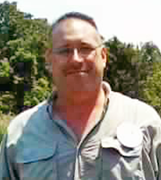Coastal Plain Forest Preserve
By Jerry Kozlansky
Silver Lake Nature Center

On a hot June day this summer, a family of four walked through the door of the Nature Center and approached me, eager to have a nature question answered. The young girl showed me an image on her smart phone of a large green moth they had seen the night before. Being from the Midwest, they had never seen such a pale green moth with a four-inch wingspan, and they wondered if I could identify it for them. Of course, being a naturalist in the eastern United States for over two decades, I immediately recognized this fascinating creature as a male luna moth.
The Silver Lake Nature Preserve is a perfect habitat for the luna moth, which is only found here in North America. The Preserve is home for all of the major host trees that the caterpillar loves to eat, especially the sweet gum tree that exists here in abundance. Without this type of tree, the luna moth caterpillar may not have enough nourishment during the summer and may not have the protection it needs to survive the long, cold winters of this region.
What this family had photographed was a newly emerged male moth that had recently crawled from its winter cocoon, which was carefully wrapped in a sweet gum leaf camouflaged on the forest floor. Adult males like this one only have a week to live. In fact, they do not even have the mouth parts to eat anything while they search for their female counterparts. Flying about at night, they sense the surrounding air with large, featherlike antennae, searching for the presence of pheromones given off by the female luna moth.
 The female moth then searches for a host plant to lay its fertilized eggs. These eggs need to hatch on a plant that the caterpillar would like to eat, perhaps a sweet gum tree at Silver Lake Nature Center. She may lay over 500 eggs in time, and in about 10 days small green caterpillars emerge and begin munching on those nutritious sweet gum leaves. Every five days the caterpillars get so large they split their skins and emerge with new skins and much plumper bodies. After doing this five times over the next three weeks they spin themselves into a cocoon, wrap themselves into a tree leaf, and the cycle begins again.
The female moth then searches for a host plant to lay its fertilized eggs. These eggs need to hatch on a plant that the caterpillar would like to eat, perhaps a sweet gum tree at Silver Lake Nature Center. She may lay over 500 eggs in time, and in about 10 days small green caterpillars emerge and begin munching on those nutritious sweet gum leaves. Every five days the caterpillars get so large they split their skins and emerge with new skins and much plumper bodies. After doing this five times over the next three weeks they spin themselves into a cocoon, wrap themselves into a tree leaf, and the cycle begins again.
The family thanked me and waved goodbye. It is my sincere hope they left with greater curiosity than they entered with. They certainly had a greater appreciation for the interrelationships between plants and animals in nature. Hopefully, you, the reader, are inspired to ask more questions, and you’re certainly invited to Silver Lake Nature Center to expand your naturalist skills.

